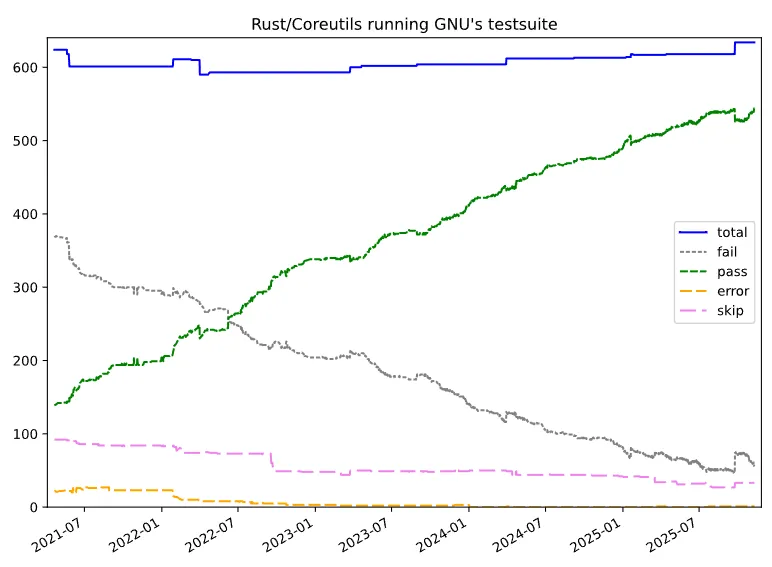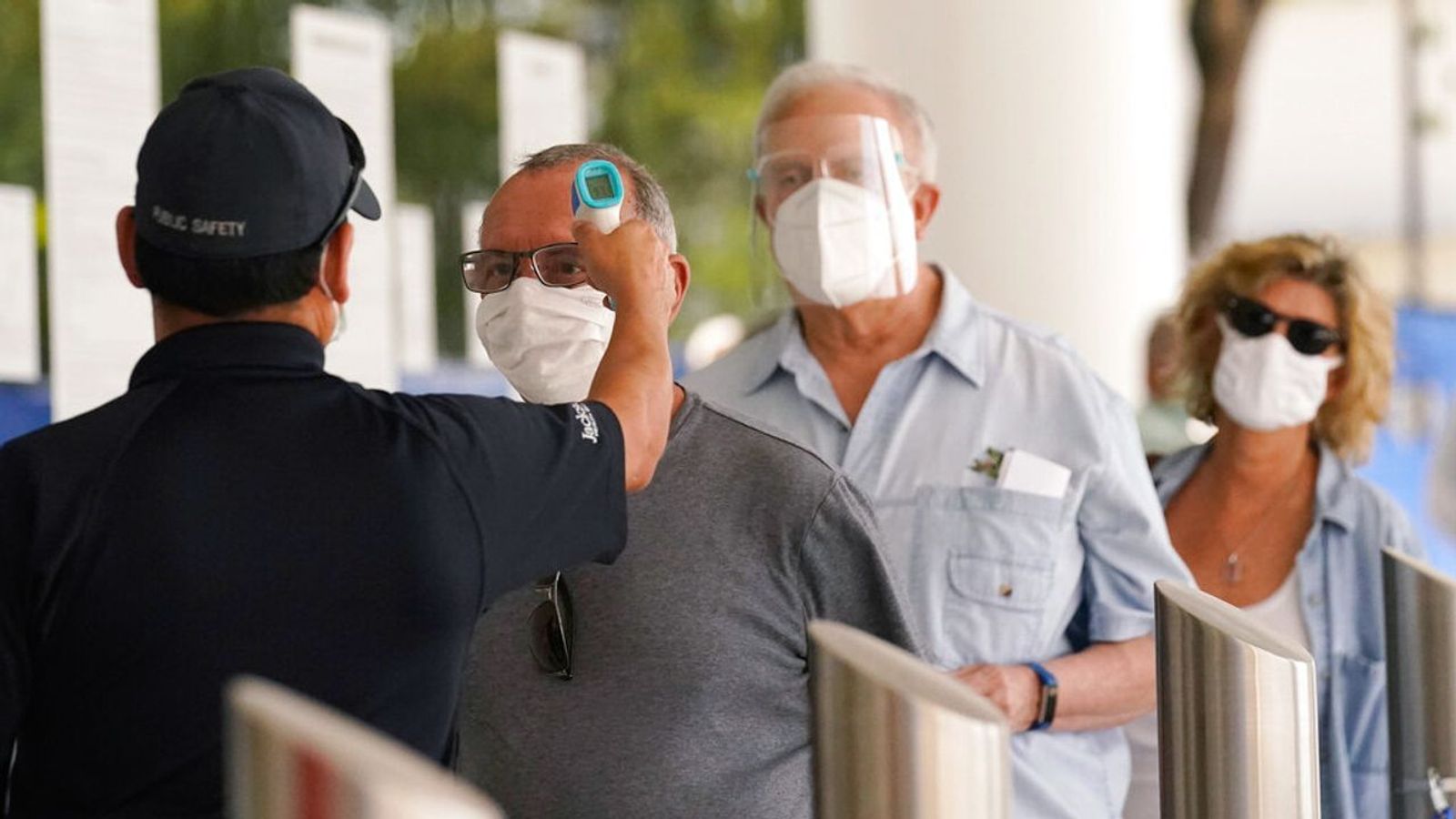This request seems a bit unusual, so we need to confirm that you’re human. Please press and hold the button until it turns completely green. Thank you for your cooperation!
Author: admin
-
Just a moment…
Just a moment… -

Harry’s ‘homesick’ letter and ‘Meghan warning’ as he parties in Canada – Celebrity News – Entertainment
Prince Harry has faced criticism this week after being compelled to deny attempting to overshadow his brother and publishing an essay on British identity — despite having departed the UK on what he termed a ‘freedom flight.’
He has been seen at…
Continue Reading
-

Rust Coreutils 0.4 Released With Better GNU Compatibility & Faster Performance
Rust Coreutils continues moving fast on their goal “toward full GNU compatibility” with the GNU Coreutils. The uutils project announced Rust Coreutils 0.4 this evening with better compatibility, performance optimizations, and other…
Continue Reading
-

Vaccines, infections and chronic diseases: A new understanding
The long-standing division between infectious (communicable) and non-communicable (chronic) diseases is collapsing under the weight of new epidemiological evidence. Mounting data reveal that viral pathogens are not transient threats but durable…
Continue Reading
-

Strong Q3 Results and $500 Million Buyback Might Change the Case for Investing in AvalonBay (AVB)
-
In late October 2025, AvalonBay Communities announced strong third quarter results with year-over-year growth in revenue and net income, confirmed new earnings guidance for the remainder of the year, and launched a new US$500 million share repurchase program with no set expiration.
-
The combination of robust operating performance, updated forward-looking expectations, and a fresh share buyback authorization highlights management’s confidence in the company’s financial health and long-term outlook.
-
To assess what this means for investors, we’ll examine how the new US$500 million repurchase plan influences AvalonBay’s investment narrative moving forward.
Outshine the giants: these 25 early-stage AI stocks could fund your retirement.
AvalonBay Communities is for investors who believe in the resilience of high-barrier coastal and urban apartment markets, supported by long-term housing undersupply and demographic trends favoring renting. The launch of a new US$500 million share buyback comes alongside steady revenue and net income growth, but it does not materially alter the primary short-term catalyst of new project lease-ups or shift the central risk from regional job market softness affecting apartment demand and rental pricing.
Among recent announcements, the confirmed full-year 2025 earnings guidance of US$7.35 to US$7.55 per share stands out as most pertinent. This forward-looking clarity helps set expectations as AvalonBay manages its apartment deliveries and assesses leasing velocity in select markets, which remains a key catalyst for future earnings growth.
Yet, in contrast to management’s confident moves, investors should also be aware of the potential impact of a slower-than-anticipated recovery in job growth, especially if…
Read the full narrative on AvalonBay Communities (it’s free!)
AvalonBay Communities is projected to reach $3.5 billion in revenue and $913.6 million in earnings by 2028. This outlook assumes a 5.5% annual revenue growth rate, but forecasts a decrease in earnings of around $286 million from the current $1.2 billion.
Uncover how AvalonBay Communities’ forecasts yield a $216.48 fair value, a 22% upside to its current price.
AVB Community Fair Values as at Nov 2025 Four Simply Wall St Community fair value estimates range from US$215 to US$321, highlighting wide differences in individual outlooks. With job market growth uncertainty still looming as a risk, you can find a variety of perspectives on AvalonBay’s future performance by exploring these community viewpoints.
Continue Reading
-
-

Evaluating Current Valuation Following Recent Share Price Movements
Valvoline (VVV) shares have edged up slightly in the past day, despite experiencing a dip of 5% over the past month. Investors watching recent price movement may notice the stock is still down 26% from a year ago.
See our latest analysis for Valvoline.
Valvoline’s share price has trended lower over the past year, with short-term slips in recent weeks hinting at softer momentum. Its five-year total shareholder return remains solidly positive. That dip may reflect shifting expectations about growth or perceived risks, even as the company’s long-term profile stays resilient.
If you’re wondering what else is on the move, now’s the perfect time to broaden your horizons and discover fast growing stocks with high insider ownership
The big question for investors now is this: with Valvoline’s recent pullback, are shares trading at an attractive discount, or is the market simply factoring in all expected growth ahead?
Valvoline’s last close at $31.56 stands notably below the narrative’s fair value of $44.12, highlighting a significant gap in expectations. The market’s caution contrasts with bold assumptions about strategic growth and recovery.
Aggressive store expansion through both company-owned and franchise models, along with ongoing acquisition of independent operators, is increasing Valvoline’s geographic reach and service capacity. This serves as a forward-looking catalyst for topline revenue growth and improved return on invested capital.
Read the complete narrative.
Curious what numbers are fueling this big valuation gap? There is more behind these analyst projections than just store growth. Uncover the surprising financial moves and profit expectations that drive this narrative’s price target.
Result: Fair Value of $44.12 (UNDERVALUED)
Have a read of the narrative in full and understand what’s behind the forecasts.
However, risks remain, including the rapid shift toward electric vehicles and increasing labor costs. These factors could threaten Valvoline’s long-term growth outlook.
Find out about the key risks to this Valvoline narrative.
Looking instead at the price-to-earnings ratio, Valvoline appears pricier than its peers. Its P/E sits at 14.4x compared to the peer average of just 9.5x. This is also higher than the fair ratio of 13.6x that the market could ultimately move toward. This gap reflects greater downside risk if sentiment changes. Could the market be overlooking something, or is this premium justified?
See what the numbers say about this price — find out in our valuation breakdown.
Continue Reading
-

Eva Longoria’s Mônot Gown Evokes Vintage Glamour in Paris
Eva Longoria opened the 2025 Global Gift Gala in Paris with a look built on Old Hollywood cues — sleek lines, soft pearl tones and a cut that moved cleanly with the body. The actress and filmmaker, returning as Honor…
Continue Reading
-

Dead Star’s Last Meal Reveals What Alien Planets Are Really Made Of : ScienceAlert
What’s the best way to reveal what an exoplanet is made of? Wait for it to get gravitationally shredded and engulfed by its star, of course!
Astronomers using the W. M. Keck Observatory on Mauna Kea, Hawaiʻi, have spotted such a gruesome…
Continue Reading
-

Too early to fret about tech pullback?
Traders work on the floor of the New York Stock Exchange (NYSE) on November 07, 2025 in New York City.
Spencer Platt | Getty Images
November is historically the best month for the S&P 500, which gains an average of 1.8% during the period, according to the Stock Trader's Almanac.
But the first full trading week of the month saw stocks caught in November rains.
The S&P 500 and Dow Jones Industrial Average each lost more than 1%, while the Nasdaq Composite shed around 3% — that's its largest weekly loss since the tech-heavy index slumped 10% in the week ended April 4.
A few months ago, tariffs were the shadows that stalked stocks. Now, it's fears that artificial intelligence-related stocks are trading at prices disconnected from what the firms are actually worth.
"You've got trillions of dollars tied up in seven stocks, for example. So, it's inevitable, with that kind of concentration, that there will be a worry about, 'You know, when will this bubble burst?'" CEO of DBS, Southeast Asia's largest bank, Tan Su Shan told CNBC.
Goldman Sachs' CEO David Solomon also thinks choppy waters might be ahead.
"It's likely there'll be a 10 to 20% drawdown in equity markets sometime in the next 12 to 24 months," Solomon said Tuesday at the Global Financial Leaders' Investment Summit in Hong Kong.
That said, a pullback isn't necessarily bad for stocks. It could even present "buying opportunities" for investors, according to Glen Smith, chief investment officer at GDS Wealth Management.
After all, earnings have been "reassuring" despite worries about tech stocks' high valuations, Kiran Ganesh, multi-asset strategist at UBS, told CNBC. That means the rain might not last and the rally could find a way to run a little longer.
— CNBC's Lee Ying Shan, Hugh Leask and Lim Hui Jie contributed to this report.
What you need to know today
Major U.S. index were mixed Friday stateside. The S&P 500 and Dow Jones Industrial Average inched up more than 0.1%, but the Nasdaq Composite closed 0.21% lower. The pan-European Stoxx 600 lost 0.55%. U.S. futures rose Sunday evening stateside.
China consumer prices pick up in October. The consumer price index, released Sunday, showed a 0.2% growth year on year. It beats analysts' expectations of zero growth and is the first month since June that prices rose.
U.S. government on track to end shutdown. Enough Democratic senators had agreed to vote for a deal that would fund the U.S. government through the end of January, a person familiar with the deal told CNBC.
Another missed jobs report. The ongoing U.S. government shutdown — which is now the longest ever — means the Bureau of Labor Statistics couldn't release its monthly employment data. Here's what economists would have expected the report to show.
[PRO] Stocks that could bounce after sell-off. Using CNBC Pro's stock screener tool, we found several names that are oversold, according to their 14-day relative strength index. This implies they could be due for a recovery in prices.
And finally...
Fluxfactory | E+ | Getty Images
A global wealth boom is fueling a rise in family office imposters
Fundraisers and fraudsters are presenting themselves as family office representatives, seeking to dupe gullible investors — and then there are also imposters who are in it just for an "ego boost," several industry veterans told CNBC.
An information vacuum seems to have encouraged imposters. In many markets, genuine single family offices, or SFOs, are exempt from registering so long as they manage only family money. That privacy norm often makes verification hard, said industry experts.
— Lee Ying Shan
Continue Reading
-

Secondary infertility is rising among couples: Doctors say these simple changes can help
You had one child with ease, then tried again and nothing? For many couples, that surprise is jarring, shame-tinged and isolating. Fertility specialists are now…
Continue Reading